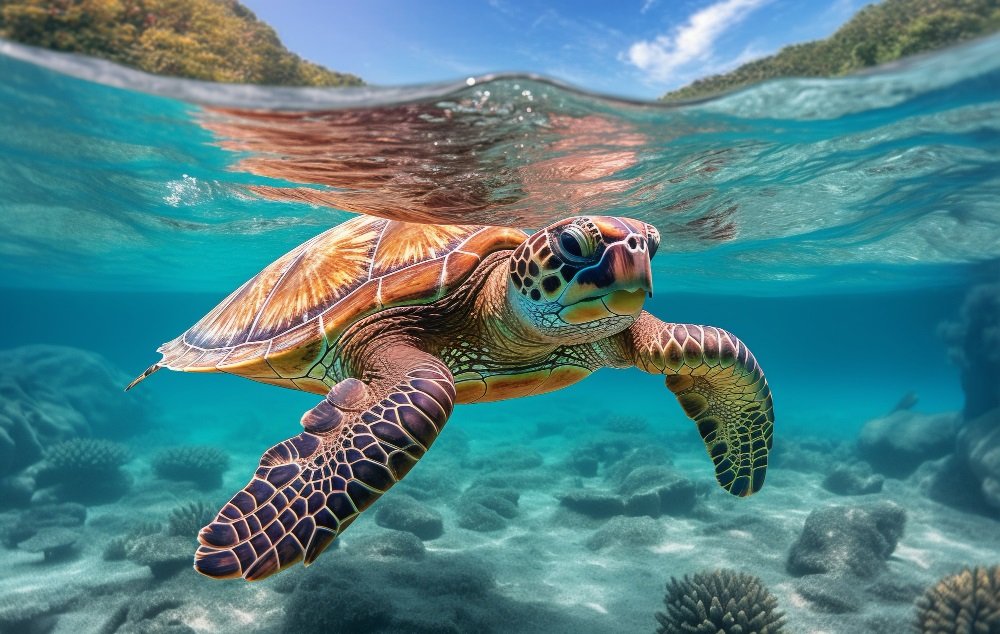Sea turtles, magnificent creatures that have roamed our oceans for millions of years, face numerous challenges in their complex life cycle. One crucial aspect of their survival is understanding where they obtain the energy they need to navigate vast distances, grow, reproduce, and ultimately thrive.
Where Do Sea Turtles Get Their Energy?
This exploration delves into the fascinating world of sea turtle nutrition, uncovering the sources that fuel their incredible journeys and sustain their existence. From the depths of the ocean to the sandy shores they call home, we will uncover the intricate relationship between sea turtles and their food sources.
A Diverse Diet for Diverse Needs
Different species of sea turtles have evolved unique dietary preferences, reflecting their adaptations to specific habitats and prey availability. Some species, like the green turtle, are primarily herbivores, grazing on seagrasses and algae. Others, such as the leatherback turtle, are carnivores, feasting on jellyfish. Understanding these dietary variations is key to comprehending the energy needs of each species.
Where Do Sea Turtles Get Their Energy?
Sea turtles, ancient mariners that have roamed the oceans for millions of years, possess a remarkable ability to survive long migrations and endure harsh environmental conditions. Their journey begins with a remarkable feat: hatching on sandy beaches and navigating vast distances to find food and breeding grounds. But how do these majestic creatures fuel their epic adventures? The answer lies in their diet and the intricate processes that allow them to extract energy from their food.
A Diverse Diet to Fuel the Journey
Sea turtles are opportunistic omnivores, meaning they consume a wide variety of plant and animal matter. Their diet varies greatly depending on the species and their habitat.
- Green Sea Turtles: Primarily herbivorous, feasting on seagrasses and algae, which provide them with essential carbohydrates and nutrients.
- Loggerhead Sea Turtles: Predominantly carnivorous, their diet consists of crabs, conchs, jellyfish, and other invertebrates, offering a rich source of protein and fats.
- Hawksbill Sea Turtles: Specialized in consuming sponges, which are found in coral reefs, providing them with unique dietary requirements.
- Leatherback Sea Turtles: The largest of all sea turtles, they have a diet primarily composed of jellyfish, which are abundant in their open-ocean habitat.
Digestion and Energy Extraction
The digestive system of a sea turtle is adapted to process the diverse foods they consume. (See Also: How Do Turtles Sleep In Water)
Sea turtles have a relatively simple digestive system compared to land mammals. Food enters their mouths and travels down their esophagus into the stomach. In the stomach, food is mixed with gastric juices that help break down proteins. The partially digested food then moves into the intestines, where further digestion and absorption of nutrients take place.
The specific adaptations in their digestive system vary depending on their diet. For example, green sea turtles have a specialized gut microbiome that allows them to efficiently digest cellulose from seagrasses. Leatherback sea turtles, on the other hand, have a unique digestive system that can handle the high water content and stinging cells of jellyfish.
Metabolic Processes and Energy Storage
Once nutrients are absorbed, they are transported throughout the sea turtle’s body to fuel various metabolic processes.
Sea turtles rely primarily on carbohydrates and fats for energy. Carbohydrates are broken down into glucose, which is used immediately for energy or stored as glycogen in the liver and muscles. Fats are broken down into fatty acids, which can be used for energy production or stored as fat reserves.
Sea turtles have a slow metabolic rate, which allows them to conserve energy during long migrations or periods of food scarcity. They can also enter a state of torpor, a temporary slowing down of metabolic processes, to further conserve energy during harsh conditions.
The Impact of Human Activities
Human activities have a significant impact on the energy balance of sea turtles. (See Also: Were Turtles Around With Dinosaurs)
- Habitat Loss and Degradation: The destruction of seagrass beds and coral reefs, vital habitats for many sea turtle species, reduces their access to food and can disrupt their feeding patterns.
- Pollution: Plastic pollution and other forms of marine debris can entangle sea turtles, obstruct their feeding, and introduce toxins into their system, impacting their energy levels and overall health.
- Climate Change: Rising sea levels and ocean acidification can alter sea turtle nesting grounds and affect the availability of their prey, further stressing their energy balance.
Conservation Efforts
Protecting sea turtles and ensuring their long-term survival requires a multifaceted approach that addresses the threats they face.
- Habitat Protection and Restoration: Establishing marine protected areas and restoring degraded habitats can help safeguard sea turtle nesting grounds and foraging areas.
- Reducing Pollution: Implementing policies to reduce plastic pollution and other forms of marine debris can minimize the risks to sea turtles.
- Climate Change Mitigation: Reducing greenhouse gas emissions is crucial to mitigating the impacts of climate change on sea turtle populations.
- Public Awareness and Education: Raising awareness about the importance of sea turtle conservation and promoting responsible practices can help reduce human-induced threats.
Recap
Sea turtles have evolved remarkable adaptations to fuel their epic journeys and survive in diverse marine environments. Their diet, digestion, and metabolic processes work in concert to extract energy from a variety of food sources. However, human activities pose significant threats to their energy balance and overall survival. Through concerted conservation efforts, we can help protect these ancient mariners and ensure that they continue to grace our oceans for generations to come.
Frequently Asked Questions about Sea Turtle Energy
What do sea turtles eat?
Sea turtles have diverse diets depending on their species. Some, like green sea turtles, are herbivores and primarily eat seagrass and algae. Others, like leatherback sea turtles, are carnivores and feed on jellyfish. Hawksbill turtles specialize in sponges, while loggerheads consume crabs, conchs, and other invertebrates.
How do sea turtles get their energy from their food?
Like all animals, sea turtles obtain energy from the food they consume through a process called cellular respiration. This involves breaking down the complex molecules in their food (carbohydrates, fats, and proteins) to release energy that their bodies can use for various functions, such as swimming, growing, and reproducing.
How often do sea turtles need to eat?
The frequency of sea turtle feeding varies greatly depending on factors like species, age, and activity level. Some species, like leatherbacks, may feed frequently on jellyfish, while others, like green sea turtles, may graze on seagrass for extended periods. (See Also: How Long Can Snapping Turtles Go Without Eating)
Do sea turtles store energy for long migrations?
Yes, sea turtles can store energy in the form of fat reserves. Before embarking on long migrations, they often increase their food intake to build up these reserves, which provide them with the energy they need to travel vast distances.
What are the biggest threats to sea turtle energy sources?
Habitat loss and degradation, pollution, and climate change all pose significant threats to sea turtle energy sources. These factors can reduce the availability of food, disrupt their feeding patterns, and impact the overall health of their ecosystems.


